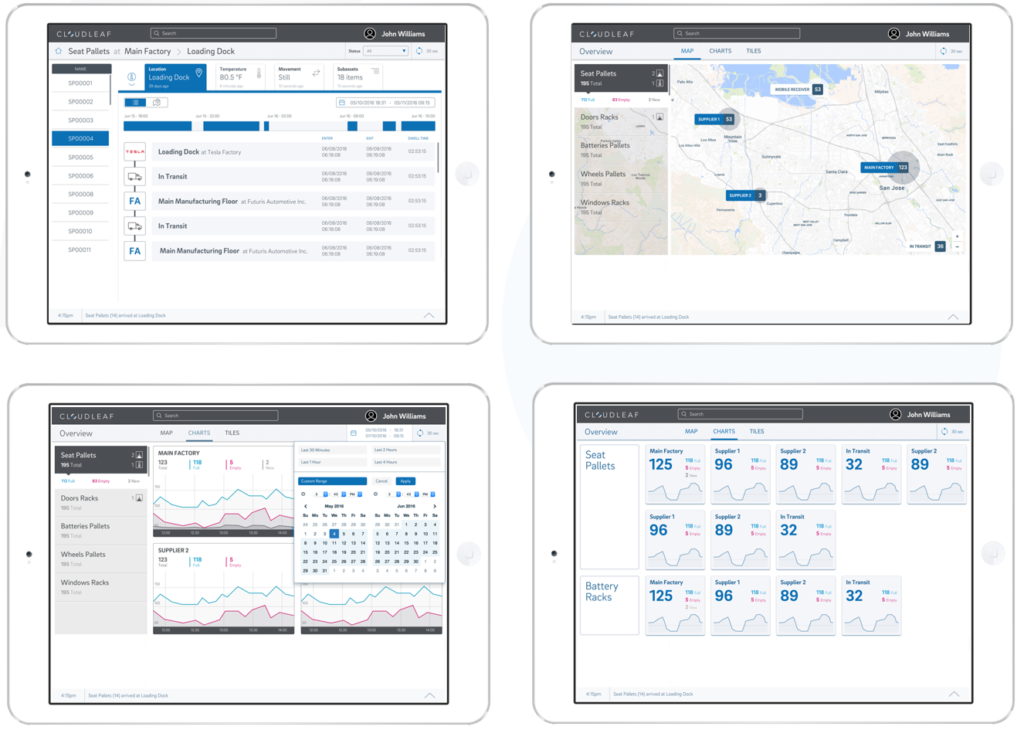Smart-Enabling Each link in a Next-Gen Supply Chain
Smart-Enabling Each link in a Next-Gen Supply Chain

Any given supply chain is evolving, fast. Globalization, the “servitization” economy and shifting customer expectations are requiring producers to be more nimble than ever before. Economic sustainability is now the name of the game, and to win it, requires a new approach focusing on stakeholder relationships, end-to-end linked supply-chains, and redefining the context in which performance is measured. And none of this is possible without information and connectivity. That means lots of sensors, measuring lots of variables plus machine-learning, data-lakes and predictive analytics
Supply Chains: Today and Tomorrow
Enterprises are moving away from reactive, forecast-dependent supply-chains. And many have already made the jump. Although asset tracking platforms are good at unlocking efficiencies, cost-value and speed, they provide managers only partial visibility over their ecosystems. This is because hybrid IoT platforms rely on a mix of technologies and are not designed to provide end-to-end coverage, visibility or scale growth. Worse yet, the extraneous data they generate add complexity and cost to the entire chain. This prevents plant managers from gaining actionable insights which results in lower productivity, higher TCO and unhappy customers.
Patrick Dixon, supply chain futurist observed, “The current supply chain model is old-fashioned, restrictive and lacking in innovation. It is time that companies seize the opportunity to reduce costs and increase efficiency by making radical changes to supply chain management through co-operation and collaboration.”
Managing assets across global supply-chains requires a holistic, all-or-nothing approach; cherry-picked upgrades just won’t cut it. It also requires next-gen connectivity that eclipses legacy wireless standards. Yes, Wi-Fi, RFID and GSM/GPS may have their niche, but they were never designed to easily and securely link massive numbers of IoT edge-devices. Complicating things, rising energy prices, globalization, security threats and regulatory pressures (e.g. government mandated reductions in CO2) are causing supply-chain managers to adopt solutions that help them better understand their operations in context with the larger economy, environment and society. End-customer expectations are also evolving. Price is no longer the only factor in their purchasing decisions.
A Broader Approach to Managing Assets Across Value-Chains
Supply-chains are becoming less inward-focused and more customer-centric. A chain that covers customers-to-suppliers that enables managers to factor external market intelligence to be into the equation. And aligning back-office SCM, CRM and ERP systems to accommodate these requirements helps managers to redefine priorities of resources and make better decisions.
John Gattorna, professor of supply chain management at Macquarie Graduate School of Management, Sydney commented, “Companies need to learn from the wider business world and consider the human element of supply.”
The push sale model is over. B2Bs and consumers are now dictating price and how products should be manufactured, sold and supported. Ethical, cultural and health concerns now factor into every purchasing or leasing decision. This is the pull sales model. But sustainability is a broad and complex topic requiring enterprises to implement better systems and measures. MIT Sloan Management Review’s recent article on the subject cited “A Three-Point Approach to Measuring Supply Chain Sustainability” that considers the following three criteria:
- Context: Understanding the broader context in which supply-chains exists by a. Gathering metrics across the entire chain, b. Establishing science based goals and, c. Evaluating these results against forecasts.
- Collaboration: Building mutually beneficial goal-based relationships with key stakeholders across the entire chain to a. Reduce supply hotspots, b. Build capacity and, c. Use a common analytics platform.
- Communication: Ensuring the flow of information across the chain by enabling data messaging and orchestration between stakeholder systems that facilitate incremental improvement and a focus on shared KPIs.
In a recent study by Oracle titled “The Shape of Tomorrow’s Supply Chains”, 36% of the supply professionals polled, thought that collaboration ensures success, ahead of legislation (32%), technology (13%). This means that cross-boundary asset management solutions help enterprises and their stakeholders build sustainable and reciprocal relationships.
Technology to the Rescue (no, really!)
Technology is an enabler. It provides the mechanism to liberate large quantities of data that, aggregated and analyzed, enhances visibility across the chain. And real-time asset tracking solutions are pivotal to enabling stakeholder collaboration. In a study, Oracle cites 48% of those polled as “…wanting predictive software to allow them to calculate the impact of their decision or those of their suppliers” and “…41% express[ing] interest in smart containers or RFID technology that can provide information about the movement of products, or energy usage through a supply pipeline”. This means that enterprises can now justify building collaborative partnerships on their bottom-line.
Quick Look: Automotive
Automotive supply-chains are expanding both in scale and scope. Connected-vehicle telematics, infotainment systems and onboard computers are putting new demands on parts sourcing, manufacturing, assembly and distribution. And with endless things to monitor, measure, and optimize, determining cause and effect is becoming difficult. Sophisticated tools will be needed to measure the effect on resources used across the chain.
Optimizing workflows several orders of separation up and down the chain isn’t easy. OEMs might know the environmental impact of producing a vehicle but what’s the impact of producing each sourced part? Or the ecological impact of generating the energy or supplying the water to produce the component?
Edgar Blanco, executive director at the MIT Centre for Transportation and Logistics points out, “companies could be counting processes in a never-ending chain.”

Cloudleaf Sensor FabricTM allows enterprises to take advantage of powerful cross-boundary visibility, real-time monitoring and granular control of the asset ecosystems across value-chains of people, processes and workflows. The solution uses next-generation RF-agnostic connectivity to link up assets-in-motion. These include patented enterprise-grade IoT-capable endpoints and gateways that form an intelligent mesh of assets that provide position and condition data to cloud analytics. Each Cloudleaf sensor generates a unique digital fingerprint that communicates position, status and condition of each asset in relation to neighboring devices and its operating environment.

This helps plant managers to easily orchestrate the flow of inventory containers, sub-assemblies and high-value tools across global supply-chains. Secure, scalable, and fully-managed, Sensor Fabric is designed with a zero-implementation footprint, eliminating potential impact on ongoing operations. Customers can literally implement the solution in the AM and be up and running and collecting data in the PM. Cloudleaf Sensor Fabric is not simply about sensors, connectivity and information, it’s about leveraging relationships between partners, suppliers and customers. IoT technologies, methodologies and tools are helping plant managers broaden their access, reach understanding of complex, globally connected supply-chains.
About Cloudleaf:
IoT is top-of-mind for enterprises looking to enable digital business transformation, but IoT has been challenging to use. Cloudleaf is changing the game for IoT by transforming how IoT is deployed and delivered.
Media Contact
Nitesh Arora, Head of Marketing
+1-415-315-9273
The post Smart-Enabling Each link in a Next-Gen Supply Chain appeared first on ReadWrite.
(66)


